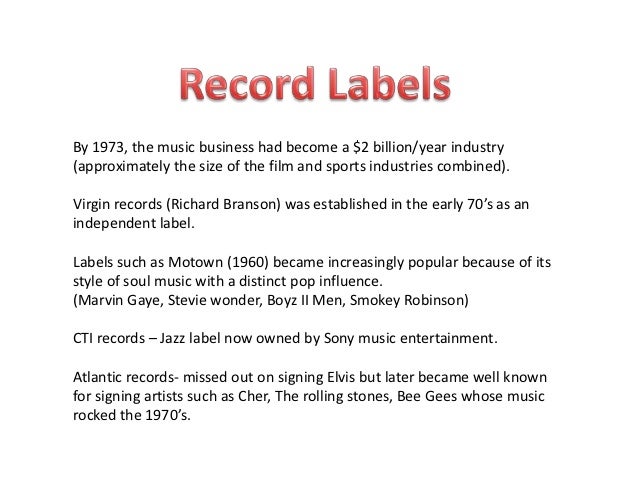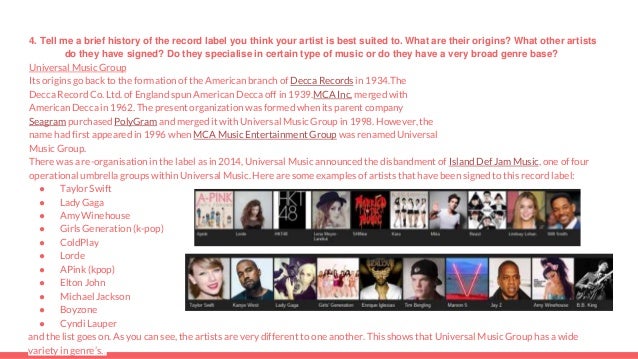38 by 1960 the major recording labels were marketing
Record Labels 1960 - Deacon Street Labels such as Tamla and Chancellor were continuing to show in 1960 that the record business was indeed the home of the American dream if you could just find the right record. But often times it was the record companies that prospered while performers profited very little. The Black Record Label That Introduced the Beatles to ... The couple's ambitions were modest: start a record company to stock the store with the music radio listeners were requesting. They borrowed $500 from a pawnbroker to record the label's first ...
The History of Stax Records Stax Records Subsidiaries . After being rocked by the 1950s payola scandals, radio stations in the 1960s were very careful about playing too many records by any one record label.For this reason, it was very common during this time for labels to start "subsidiary" labels - which essentially amounted to releasing an album through the main label with the name of another label on the album jacket.

By 1960 the major recording labels were marketing
The Columbia Records Story - History and Artists The label earned a reputation as the most commercially successful of non-rock labels. Columbia Records did not make a significant impact in rock music until the late 1960s. However, Columbia Records did bid to purchase the contract of Elvis Presley from Sun Records. However, they were turned down in favor of RCA. History of Rock and Roll Chapter 2 Flashcards | Quizlet 2. blacklisted by many record labels 3. helped define the role of the producer ... in the early 1960s, the major labels tried to regain the rock and roll market by: 1. creating new labels ... the most important folk scenes from the early 1960s were typically found in rural areas in the South: true or false. Top 10 major Record Labels. A record label is a brand in ... A record label is a brand in the music industry that works in the publishing and marketing of music videos and recordings. It goes through a long list of processes including scouting talents from…
By 1960 the major recording labels were marketing. 11 Record Labels In NYC & The Type Of Music They Release ... Fool's Gold Records is an independent record label in Brooklyn, New York.. The label was founded in 2005 and brings all genres together - it's known as a tastemaker label and was dubbed an "indie innovator" by Billboard and "one of the most influential indies in the music business" by Pitchfork.. While the label is run independently, it is distributed by Universal Music Group. 60s Motown: When An Independent Detroit Record Label Ruled ... Motown's 60s represented the label's commercial peak. It had built from almost nothing to a recording empire. By 1969 the music business was changing, with an emphasis on the long-playing album,... Major Record Labels As Dinosaurs? - Forbes From the 1960s on, the LP album gave the music industry a main product to push, and business was good. In the 1990s the widespread acceptance of the Compact Disc format gave a giant boost to the... Autumn Records - Wikipedia Autumn was probably one of the most successful independent record labels in the mid-1960s, but changes in the record-buying public's tastes and major marketing by already established bigger labels (nearly every major record company signed a heavy psychedelic band in the late 1960s) led to the demise of Autumn in 1966.
Past | The Evolution of Music Marketing "Music marketing" in the paper means a music label's strategies to promote its new music, usually by airing the songs in radio or on TV. "Traditional media" means radio and television. They are major media for broadcasting music. "Major labels" means international labels, including SonyBMG, Universal, EMI and Warner. Category:Record labels established in 1960 - Wikipedia Categories: Record labels established in the 1960s. Entertainment companies established in 1960. Mass media companies established in 1960. 1960 in music. Record labels by year of establishment. Hidden categories: Navseasoncats year and decade. As addressed in Chapter 5, why were the independent labels ... This changed in the 1960s, when the major labels began to realize the popularity of rock 'n' roll and started to invest in it. Major labels began to make use of the same tactics as independent labels, with regard to how they signed new artists. Market share of record companies in the U.S. by label ... Data on the album plus track equivalent albums (TEA) market share of record companies in the United States showed that independent record labels held a market share of 35.13 of all U.S. sales in...
How 'Race Records' Turned Black Music Into Big Business Smith then recorded "Crazy Blues," the first blues record. This time, it sold 100,000 copies, and other record labels hustled to get in on the trend. Suddenly, every label wanted to produce "race... Music history Quiz 4 Flashcards Rodgers and Hammerstein. Term. Which format, released in 1948, became the major record labels' primary format to sell musical soundtracks? Definition. 33 1/3, 12 inch vinyl. Term. What composer is best known for film and TV scores like Peter Gunn and the Pink Panther, as well as winning 4 Oscars and 20 Grammy's? Definition. 10 Largest Record Labels in the World - Largest.org Music is a huge aspect of human culture, allowing artists to express themselves and share their messages with people all around the world. While an increasing number of artists have chosen to sign with independent labels during the past few years, many still hope to make it big by getting in with major record labels that are universally respected and highly profitable. The Record Label's Role in the Music Industry Marketing is one of a record label's most important functions, as public awareness of their brand and associated artists is the way it makes money. Record label logos and their contact information once figured prominently in the center of vinyl records, which is how labels such as Arista, Capitol, and Epic became household names. Major Labels
Golden Crest Records: The Independent Record Industry ... By 1960 Golden Crest had a network of about 20 national distributors, covering all the important markets from New York to California to get its product to the teen buyers, but lacking a regular stream of hits, the label was never a promotional priority for these distributors. [11] Recording Studio
History of R&R CH 2 Flashcards | Quizlet Most of rock's originators and many of the independent labels they worked for were out of the music business by 1960. True Both independent and major record labels used payola. True Cover versions of rhythm and blues songs by white artists very rarely performed better on the pop charts than the rhythm and blues originals.
Major Pop Record Labels: The Big Three - LiveAbout The major labels today are all three media conglomerates that operate a number of specific label imprints, or the actual company logo stamped on the recording. Consolidations brought the number of major labels down from six in 1999 to three today. Major labels account for about 70 percent of music sales by recent estimates. 01 of 03
The Independent Record Labels of the 1950's and 1960's ... Spector is an example of an independent record label whose niche was filled up by another entity. In England during the 1950s and 1960s, EMI, Philips, and Decca towered over small independent record labels as a trio of major record companies. As a result, it was quite difficult for the independent labels to become established.
Philips Record Label | history The Philips record label was started in the Netherlands by Philips Phonographische Industries (PPI) in June 1950 when it began issuing classical 78 rpm recordings. Recordings were also made with popular artists of various nationalities and with classical artists from Germany, France and Holland. The first British recordings on the label were ...
6.4 Current Popular Trends in the Music Industry ... Between 1950 and 1980, a large number of major record labels and numerous independent labels competed for a share of the musical pie. Gradually, the larger labels began buying up the independent labels, and then started trying to purchase each other. By the late 1990s, only six major labels remained: Warner, Universal, Sony, BMG, EMI, and Polygram.
1950s Rock and Roll: A Decade of Music That Changed the ... In record-business terms, rock & roll meant that small, formerly specialized labels like Sun, Chess and Specialty were invading the upper reaches of the pop charts, long the exclusive domain of the...
Record labels in the U.S. - Statistics & Facts | Statista This means that record companies are faced with the challenge of promoting their artists and finding ways to ensure that they are getting paid for their work in an increasingly digital industry....






Post a Comment for "38 by 1960 the major recording labels were marketing"